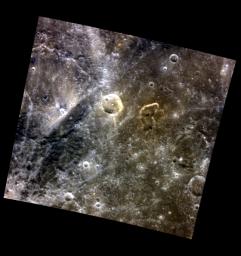This color view of Mercury's surface highlights what may be an old volcanic vent. Just to the right of center, within a brown-red patch, is an irregularly shaped 30-km depression depression, in this case the irregular shape is a bit like a butterfly. While most of these suspected volcanic vents are located within impact craters (like this one), the butterfly-shaped vent is not clearly associated with any crater. It also appears that it may be older than other vents, resulting in more subdued details and colors.
This image was acquired as part of MDIS's high-resolution 3-color imaging campaign. The map produced from this campaign complements the 8-color base map (at an average resolution of 1 km/pixel) acquired during MESSENGER's primary mission by imaging Mercury's surface in a subset of the color filters at the highest resolution possible. The three narrow-band color filters are centered at wavelengths of 430 nm, 750 nm, and 1000 nm, and image resolutions generally range from 100 to 400 meters/pixel in the northern hemisphere.
Date acquired: July 11, 2014
Image Mission Elapsed Time (MET): 47381178, 47381170, 47381174
Image ID: 6661702, 6661700, 6661701
Instrument: Wide Angle Camera (WAC) of the Mercury Dual Imaging System (MDIS)
WAC filters: 9, 7, 6 (996, 748, 433 nanometers) in red, green, and blue
Center Latitude: 32.08°
Center Longitude: 21.71° E
Resolution: 243 meters/pixel
Scale: This scene is approximately 250 km (155 miles) across
Incidence Angle: 32.7°
Emission Angle: 0.5°
Phase Angle: 33.2°
The MESSENGER spacecraft is the first ever to orbit the planet Mercury, and the spacecraft's seven scientific instruments and radio science investigation are unraveling the history and evolution of the Solar System's innermost planet. During the first two years of orbital operations, MESSENGER acquired over 150,000 images and extensive other data sets. MESSENGER is capable of continuing orbital operations until early 2015.
For information regarding the use of images, see the MESSENGER image use policy.

 Planetary Data System
Planetary Data System












